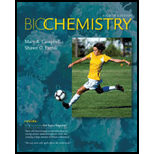
Concept explainers
RECALL How does the catalytic effectiveness of enzymes compare with that of nonenzymatic catalysts?
Interpretation:
The comparison between the catalytic effectiveness of the enzyme and the nonenzymatic catalysts.
Concept introduction:
The process through which the rate of a chemical reaction is increased is termed as catalysis. The functional proteins and some self-splicing ribonucleic acid molecules serve to increase the rate of a reaction and they are known as catalysts. In the biological system, they are known as enzymes.
Enzymes are largely organic in nature and are produced by the organism’s body itself, while catalysts can be organic or inorganic in nature. The catalysts and enzymes are not used up in the chemical reaction, they just alter the rate of the reaction.
Answer to Problem 1RE
The enzymatic catalysts are mainly proteins and some RNA molecules that show higher catalytic activity in terms of specificity, the speed of the reaction than nonenzymatic catalysts, which are organic or inorganic molecules.
Explanation of Solution
The difference between the enzymatic catalysts and nonenzymatic catalysts are as follows:
| Enzymatic catalyst | Nonenzymatic catalyst |
| The enzymatic catalysts are complex proteins and speed up the chemical reactions that occur in the biological system. | The nonenzymatic catalyst increases or decreases the rate of chemical reactions that occur outside the biological system. |
| The enzymatic catalysts are highly specific in nature. | The nonenzymatic catalysts are not very specific in nature. |
| The enzymatic catalysts increase the rate of reaction by an order of 1020. | The nonenzymatic catalysts are comparatively slower and increase the rate of reaction about 102 to 104 times. |
| The enzyme catalyst requires optimum physiological conditions. | The nonenzymatic catalysts require high temperature or pressure. |
Therefore, it can be concluded that the catalytic effectiveness of the enzymatic catalyst is higher than that of a nonenzymatic catalyst. The enzymatic catalyst is more specific in nature than the nonenzymatic catalyst.
Want to see more full solutions like this?
Chapter 6 Solutions
Biochemistry
- Which type of enzyme catalyses the following reaction? oxidoreductase, transferase, hydrolase, lyase, isomerase, or ligase.arrow_forward+NH+ CO₂ +P H₂N + ATP H₂N NH₂ +ADParrow_forwardWhich type of enzyme catalyses the following reaction? oxidoreductase, transferase, hydrolase, lyase, isomerase, or ligase.arrow_forward
- Which features of the curves in Figure 30-2 indicates that the enzyme is not consumed in the overall reaction? ES is lower in energy that E + S and EP is lower in energy than E + P. What does this tell you about the stability of ES versus E + S and EP versus E + P.arrow_forwardLooking at the figure 30-5 what intermolecular forces are present between the substrate and the enzyme and the substrate and cofactors.arrow_forwardprovide short answers to the followings Urgent!arrow_forward
- Pyruvate is accepted into the TCA cycle by a “feeder” reaction using the pyruvatedehydrogenase complex, resulting in acetyl-CoA and CO2. Provide a full mechanismfor this reaction utilizing the TPP cofactor. Include the roles of all cofactors.arrow_forwardB- Vitamins are converted readily into important metabolic cofactors. Deficiency inany one of them has serious side effects. a. The disease beriberi results from a vitamin B 1 (Thiamine) deficiency and ischaracterized by cardiac and neurological symptoms. One key diagnostic forthis disease is an increased level of pyruvate and α-ketoglutarate in thebloodstream. How does this vitamin deficiency lead to increased serumlevels of these factors? b. What would you expect the effect on the TCA intermediates for a patientsuffering from vitamin B 5 deficiency? c. What would you expect the effect on the TCA intermediates for a patientsuffering from vitamin B 2 /B 3 deficiency?arrow_forwardDraw the Krebs Cycle and show the entry points for the amino acids Alanine,Glutamic Acid, Asparagine, and Valine into the Krebs Cycle - (Draw the Mechanism). How many rounds of Krebs will be required to waste all Carbons of Glutamic Acidas CO2?arrow_forward
 BiochemistryBiochemistryISBN:9781305961135Author:Mary K. Campbell, Shawn O. Farrell, Owen M. McDougalPublisher:Cengage Learning
BiochemistryBiochemistryISBN:9781305961135Author:Mary K. Campbell, Shawn O. Farrell, Owen M. McDougalPublisher:Cengage Learning
